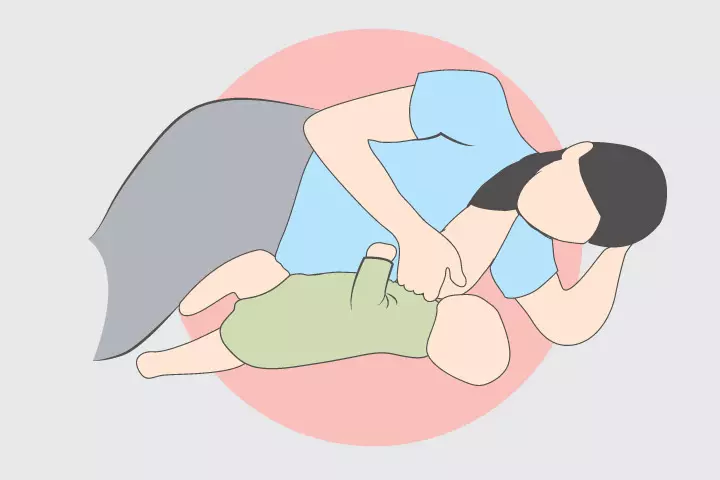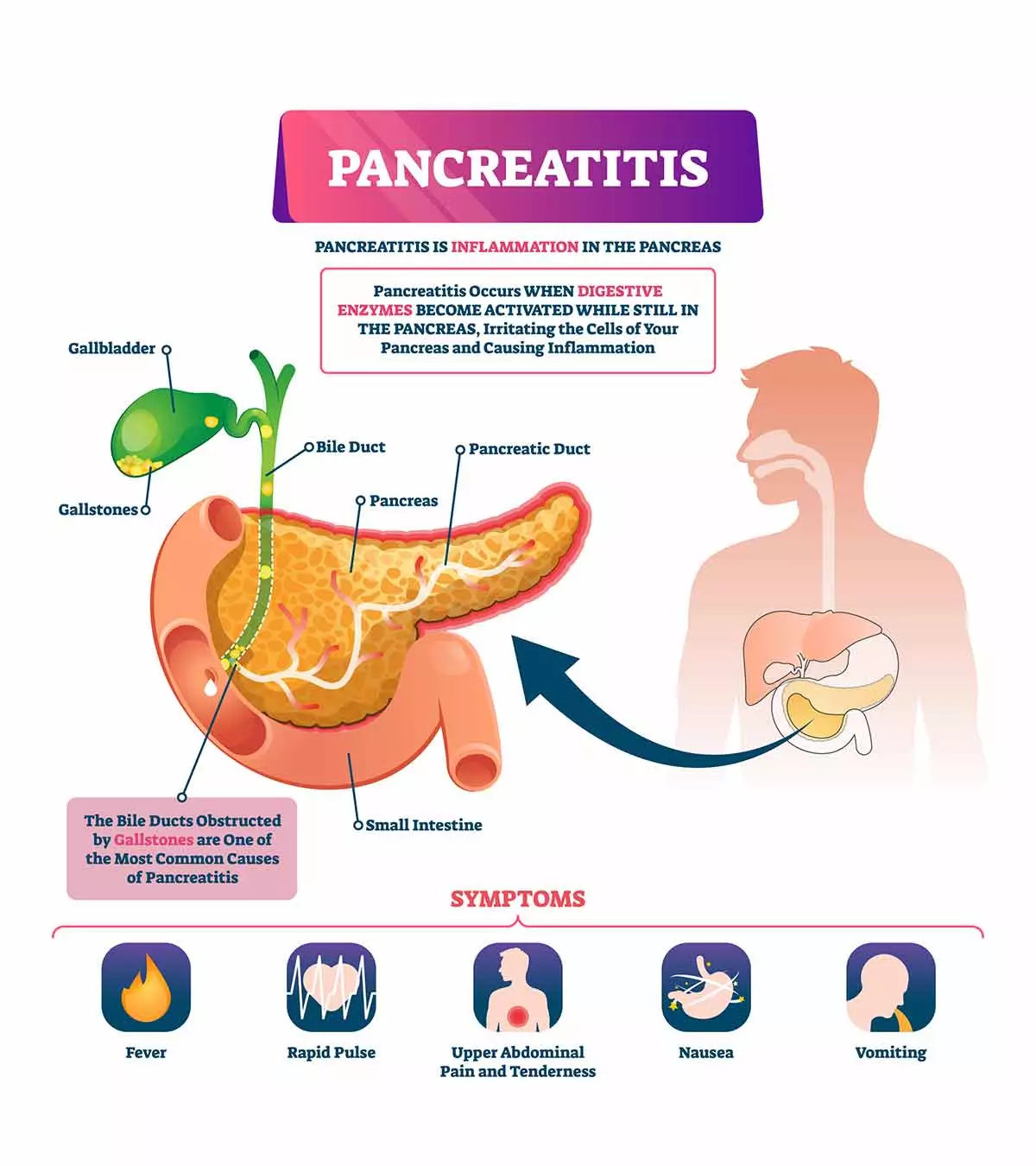

Image: Shutterstock
Breastfeeding a newborn is one of the most wonderful times for a mother and her little one. If you are a new mom who just began breastfeeding, learning about some breastfeeding techniques and knacks could help you feed your baby with utmost comfort. Though a natural phenomenon, breastfeeding is a skill that needs to be practiced with patience. Being new to this skill, most moms have a tough time feeding their newborns. However, if you are one among them, reading this post could help you understand the various breastfeeding positions and tips for feeding your baby in a relaxed manner.
When Can You Start Breastfeeding?
Your newborn will be ready and eager to breastfeed soon after birth. Place your little one skin-to-skin as often as possible during the initial days of birth. It will help your baby adjust to the environment outside and for better breastfeeding (1). Babies start displaying various behaviors like sucking, licking, bringing their fingers near the mouth, rooting, and nuzzling nipples. The feedings at this time will have an everlasting effect on both you and your baby.
As your baby grows, they will feed often and be sleepless. Healthy and full-term babies may breastfeed every hour, usually in the late night or early morning hours (2). Your baby will feel satisfied when you respond to their cluster feeding needs.
Breastfeeding After A C-Section
If you have been given an epidural and your surgery went well, you can breastfeed your newborn as soon as possible after birth. However, if you had general anesthesia or had any complications during the procedure, you may need more time to breastfeed the baby.
So if you can, you should feed your baby soon after delivery at least 8 to 12 times or the next 24 hours. Once you start feeding your little one regularly, your milk supply will also increase.
Breastfeeding Techniques That Work
Look at some time-tested breastfeeding positions that may help nursing go smoothly (3) (4) (5).
1. Cradle Hold:
Image: Shutterstock
It is a natural and most comfortable position for older babies who can handle their head better.
Here are the basic steps for this technique:
- Sit comfortably with your baby at the level of your heart.
- Cradle your little one in your arm with their tummy against yours and head resting in your elbow bend. The baby’s ear, shoulders, and hip should follow a straight line.
- Place your baby’s lower arm under your breast or your underarm with their mouth near your breast.
- Using your free hand to support your breast.
- Rest your thumb above the areola and the rest of the fingers beneath the breast.
- Now gently fondle your nipple on their lower lip. In response to the rooting reflex, the baby’s mouth opens wide, taking some time.
- Pull her quickly onto the breast and let her latch-on.
- In another variation, the laid-back breastfeeding, the mother rests in a reclined position with the tummy-to-tummy contact with the baby where their instincts work to get on the breast. Again, it is a learning process that takes time for the baby to latch on.
2. Cross Cradle Hold:
Image: Shutterstock
It is another common breastfeeding position that is also known as crossover hold. It offers great support to the baby, and the mother will have complete control over her baby with just one hand.
Here are the basic steps for this technique:
- Sit comfortably with your baby at the level of your heart.
- Cradle your little one in your arm with their tummy against yours and your hand at their head base and neck. Their ear, shoulders, and hip should follow a straight line.
- Place your baby’s lower arm out of the way with their mouth near your breast. Here you will use opposite arms from the cradle hold position.
- Use your free hand to support your breast.
- Rest your thumb above the areola and the rest of the fingers beneath the breast.
- Now gently fondle your nipple on their lower lip. The baby’s mouth opens wide in response to the rooting reflex, which takes some time.
- Pull them quickly onto the breast and let them latch on. Do not lean over your baby; instead, pull them near you.
This position works well when you:
- Nurse a newborn
- Are learning how to position an infant correctly
3. Football Hold:
Image: Shutterstock
The football hold is ideal for a mother whose breasts are very large or who had a C-section. It is also a perfect position for premature babies or tiny babies as it gives excellent control to the mother over the baby.
Here are the basic steps for this technique:
- Place your baby so that her legs and body are beneath your arm and your hand at the base of the head and neck.
- Place your palm below the breast and let your little one latch on by pulling them close. Next, hold your baby’s head with their chin and nose touching your breast.
- When the baby latches on, the mother should make sure that her shoulders are relaxed.
This position works well when:
- You have undergone a C-section and want to hold your baby against the incision of the abdomen
- Your breasts are large
- You want to check in your baby latch-on
- Your little one is restless and fussy
- You have inverted nipples
4. Football Hold For Twins:
Image: Shutterstock
If you are a mother of twin babies, you might want to feed them separately or simultaneously. If you wish to feed them simultaneously, you could try the clutch or ‘football hold’ to allow each infant to latch onto each breast.
Here are the basic steps for this technique:
- With one baby in each of your arms, hold them while partially bending your elbow.
- You can also place your babies on a pillow each.
- Support their neck with your palm, let them incline towards your body.
- Let your babies latch on and suckle.
This method is a good choice when:
- You have undergone a C-section
- Your breasts are large
- You have a tiny baby
- You have a forceful milk ejection reflex
5. Side-lying Position:
Image: Shutterstock
The side-lying position is best when the mother needs some rest while nursing her baby. It is tricky, but once both the mother and her baby get the hang of it, it will become the most favorable position. It is best recommended for those who have undergone a C-section.
Here are the basic steps for this technique:
- Position yourself and your infant towards side tummy to tummy.
- Bend your upper leg and position your upper knee with pillows.
- Lift your breast upward by placing fingers below and then take your baby close to latch-on.
This position is a good choice when:
- You need to lie flat after a C-section
- You are facing discomfort while sitting due to hemorrhoid pain
- You want to take a rest.
Latching on
If your newborn latches on to your nipple but not the areola, problems can occur like sore nipples and poor milk supply. In such a case, you have to repeat some steps for your baby to latch on properly:
- Sit with your tummy facing against your baby’s tummy.
- Ensure that your baby’s ear, shoulder and hip lie straight and nose is on the same level as nipple.
- Touch nipple to your little one’s lips
- Bring the baby close to your chest
- When the baby’s mouth opens wide, bring them to your breast quickly so that they latch on.
Here is what you need to look for after your baby latches-on:
- Chin touches your breast
- Tongue is seen when the lower lip is pulled
- Lips should be outward towards the breast
- The sucking motion will be along the jaw
- The ears, shoulder, and hip will lie in a straight line
- You should feel a rhythmic tug on your breast
- Ears wiggle
- Cheeks are round
- You will not hear smacking or clicking noises
- You will hear swallowing
- While your baby takes off breastfeeding, your nipples are not flattened
- Your baby ends the feeding with great satisfaction, looks relaxed, falls off the breasts with open hands, and immediately falls asleep.
Tips For Every Breastfeeding Technique
Support Your Body (5):
- Use a comfortable chair with armrests and pillows for extra support to your arms and back.
- Keep a footstool or coffee table so that you rest your feet and do not bend over much. A pillow or a folded blanket on your lap also keeps you comfortable.
- Whatever may be the nursing position, you should make sure you bring your baby closer to your breast.
Support Your Breast:
- Breasts turn heavier and larger when lactating. Therefore, you should use your hand to support them using a C-hold (4 fingers below the breast and thumb above) or a V-hold (between the index and middle finger).
Support Your Baby:
- Use your hand and arm along with a folded blanket or pillows to offer support to your baby’s head, neck, back, and hips.
- You can wrap her in a blanket or hold them in your arms to make them feel comfortable.
Alternative Feeding:
- Experiment and find the best position that you and your baby feel comfortable.
- Regularly alternate the breast holds since continuous hold can put pressure and cause sore nipples.
- Alternating the breast holds will also boost milk production.
Relax Before Nursing:
Close your eyes, take a few deep breaths, stay calm, and keep water, juice, or a glass of milk while you nurse since you may feel dehydrated.
Time To Stop Feeding
If you feel there is a need to stop the feed for any reason, slowly insert your finger near the corner of your baby’s mouth. A gentle pop will break the feed, and you can pull off your little one.
Frequently Asked Questions
1. Is there a wrong position to breastfeed?
Leaning forward and hunching over the baby may be the wrong breastfeeding position. This may lead to back and neck problems. Raise your feet off the floor using a stool and ensure your shoulders are relaxed when feeding your baby (6) (7).
2. How do I know if my breastfed baby is overfed?
It is unlikely for a breastfed baby to be overfed, and it is normal for newborns to feed frequently. Your baby will not become demanding as you feed them when hungry or for comfort (8).
3. What are the common breastfeeding mistakes?
Some common breastfeeding mistakes may include (9)
- Improper latch: Some babies may stop sucking after two to three trials if they are not latched on well. Help your baby by getting the milk flowing before they latch and get a secure latch.
- Breast at an angle: Keep your fingers holding the breast parallel with your baby’s lips so that the breast’s shape resembles her mouth for a comfortable fit.
- Baby’s upper lip is high: The lower lip reaches just below the base of the nipple. It should ideally reach the area below the nipple and ensure it by bringing the baby close to the breast.
Breastfeeding is not always an easy journey for some new moms. It is a skill that mothers gradually get better at with practice. However, being aware of some breastfeeding techniques could help reduce the hassle of feeding your newborn. The cradle, football, and side-lying positions are among the most effective feeding methods for babies. Additionally, ensure you and your baby have adequate support while breastfeeding and alternate between the breasts regularly to boost milk production. Most importantly, relax and ensure you are hydrated before each nursing session.
References
- Breastfeeding from the first hour of birth: What works and what hurts.
https://www.unicef.org/stories/breastfeeding-first-hour-birth-what-works-and-what-hurts - How Much and How Often to Breastfeed.
https://www.cdc.gov/nutrition/infantandtoddlernutrition/breastfeeding/how-much-and-how-often.html - Breastfeeding positions: in pictures.
https://raisingchildren.net.au/newborns/breastfeeding-bottle-feeding/how-to-breastfeed/breastfeeding-positions-pictures - How to breastfeed.
https://www.nhs.uk/start-for-life/baby/feeding-your-baby/breastfeeding/how-to-breastfeed/breastfeeding-positions/ - Positioning.
https://llli.org/breastfeeding-info/positioning/ - Breastfeeding with sore nipples.
https://llli.org/breastfeeding-info/breastfeeding-sore-nipples/ - Latching Issues? Try These 5 Breastfeeding Positions.
https://www.michiganmedicine.org/lifestyle/latching-issues-try-these-5-breastfeeding-positions - Your breastfeeding questions answered.
https://www.nhs.uk/conditions/baby/breastfeeding-and-bottle-feeding/breastfeeding/your-questions-answered/ - Common Breastfeeding Mistakes.
https://med.stanford.edu/newborns/professional-education/breastfeeding/abcs-of-breastfeeding/common-breastfeeding-mistakes.html
Community Experiences
Join the conversation and become a part of our nurturing community! Share your stories, experiences, and insights to connect with fellow parents.
Read full bio of Rebecca Koyf
Read full bio of Jessica Albert




















